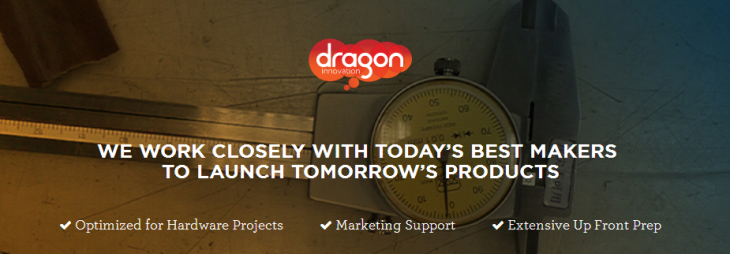
Jackson Bond is the co-founder of Relayr, the team behind the WunderBar – a set of wireless detachable sensors and smart modules, all of which can be monitored and controlled from your phone and web apps.
After deciding to launch a crowdfunding campaign for our product, we landed on the date of December 16th, 2013. Nothing about this sounds out of the ordinary, except that we had chosen this date just four weeks prior to when we needed to launch.
Our freelance marketer told us we were crazy.
Here’s our story.
1) Deciding to do it
The hardware renaissance in startups over the past few years, coupled with the accelerating interest in the Internet of Things, led us to seriously consider crowdfunding.
Crowdfunding isn’t just about the money. Anyone who thinks so is naive.
Even “unsuccessful” projects (i.e. those that fell short of their goals) got so much publicity that they have powered on to be – ironically – successful. Take a look at the huge publicity that Ubuntu got from it’s ambitious attempt to raise $32 million (and successfully raising over $12 million in the process):
Crowdfunding in ICT has become a way to test the market and to gain some visibility, as well as get a nice cash injection to further the project. Many exciting electronics projects are being built in entrepreneur’s garages and rented offices around the world as we speak.
Community is the future for funding promising technological developments that people want and that larger, inflexible corporations are unwilling to build.
2) Choosing the platform
Considering that Relayr had not had the time to build a large loyal community, we needed a platform with the authority to draw people to our project and one that frequently attracted tech enthusiasts. The Internet of Things (IoT) is trending in Kickstarter, which indicated to us that a hardware crowdfunding project was a good move to make.
An overview of some current and recent projects shows the Ninja Sphere has far surpassed its target. SmartThings has also done exceedingly well. There are a plethora of Arduino projects also with healthy funding.
However, we wanted something more specific to our product. In our research for the right options, we discovered Dragon Innovation, a crowdfunding platform specific to hardware startups. The site has an amazing track record, having worked with Pebble to deliver on its Kickstarter commitment of 85,000 watches.
The team has since helped Pebble scale its manufacturing as well as work with on the second generation Pebble Steel. From our research, it appears Dragon Innovation has the knowledge and know-how of how to run a hardware crowdfunding campaign.
The commitment to the before, during and after process convinced us that this was the best platform for the Wunderbar. We survived the tough vetting process and discussed our next steps.
3) Agreeing on the amount
“…in order for your project to be a success you must raise at least 30 percent from your own personal network.” – Ruth Hedges
Considering the aforementioned shortcoming of a big loyal community, we knew we would rely more on our personal networks and marketing if we wanted to reach our goal.
Our initial goal was $50,000. We were confident that we would exceed our target but we did not want to tempt trouble by asking for too much and losing it all.
We’ve read too many stories of startups who aimed ridiculously high, and all the preparations, time and effort in the PR and marketing went to waste. However, with the weight and network of Dragon Innovation behind us, we increased it to $91,000.
With this amount, we can guarantee a better product and faster production for our customers over the next few months.
4) Listing what we had to prepare
Our initial goal of launching on the December 16 began to look quite unrealistic when the full extent of the preparations became clear. Filming the promotional video three days in advance of the original date convinced us that we could wait until after the Christmas season had passed.
Here’s what you need in advance of launching a crowdfunding campaign:
- a well-shot promotional video (82% more likely to get funded)
- a simple, passionate and interesting script
- a detailed description of everything to do with your product
- good photographs showing all the features
- publicity
- community
…and after all that, you need to be approved by the crowdfunding platform.
Whew.
We jumped on board.
Decisions:
- invest in a good video production
- get a social media intern
- get a freelance marketer
- design a strategy and tweak it week by week
5) Hiring for the project
No one on the team had the time to grow a community around the WunderBar or find journalists interested in it. With that, it seemed logical to search out someone for the social media campaign and someone for the marketing.
Through the network at Startupbootcamp Amsterdam, we were able to source two people rapidly. For those of you less lucky, outsourcing would also be an option (Elance/oDesk, Fiverr).
6) Creating a visibility strategy
Whilst there are paid ad options, the best way of gaining visibility is through guest blogging and building an interested community across Twitter, Facebook and LinkedIn. So we built a special preview landing page for our product, very closely resembling a crowdfunding presentation, but without film and perks, and we drove traffic at it.
We discovered early on from Google Analytics that LinkedIn was driving the most traffic, closely followed by Facebook. We needed to build a Twitter following and a Google+ community.
Keyword research showed us that we should target hobbyists, DIY enthusiasts, electronics geeks, internet of things evangelists and tech enthusiasts. We built an extensive list of groups and communities where we could find these people.
The next step was to list the best “Internet of Things” publications and interested journalists. These would be the building blocks of our outreach strategy – asking for reviews and mentions, and where to send the big PR release when the time came.
These blogs and journalists would also be the list of locations we attempted to get a guest blog published. If you can’t get someone else to write about you, you can always write about yourself!
Of course, guest blogging is not about writing self-reviews. But it is a proven way of building an interested community, gaining visibility by offering your knowledge and getting links back to your website or project.
It’s tough getting published in places that have never heard of you, especially with no writing credentials. And over the holidays, it’s even harder! However, with a plan and perseverance we started to see articles appearing about us during December. Momentum was beginning to build.
7) Finalizing the rewards
An essential part of a successful crowdfunding campaign is to get the balance of the rewards right. A cheap trick such as a pen for $50 is an insult to a generous backer, but we didn’t want to go broke either trying to honor impossible commitments.
Based on math and a reasonable time to manufacture each perk, we carefully chose what would be offered and importantly – the limits of each perk. Creating scarcity is an old marketing ploy that is still highly effective.
8) Building up momentum
One month later, we had 10x the Twitter followers, had been featured on Postscapes, Beekn and BestTechie and more publications were interested in covering us. The video was uploaded to YouTube and is generating a good amount of interest.
As predicted, getting major media coverage was really tough since we’re not a well-known startup, plus we were dealing with competition in the news about the holidays and the CES conference. But we are sure our product will bring tons of value to people, and that’s the bottom line in a crowdfunding campaign.
9) Launched!
In January, we finalized plans with Dragon Innovation, and launched on January 17th – Demo Day at Startupbootcamp Amsterdam (where we were graduating from!). We’ve hit 30% funding in six days and have already sold out two of our top perks!
Six days into it, the University of Amsterdam’s very innovative System & Network engineering department made a special order of 20, plus a workshop, for their students, to kickstart their own Internet of Things momentum.
10) The next steps: after launching
Things to do:
- constant interactions and conversations on social media (all platforms)
- keep searching for media coverage
- a drip email campaign to our curated list of interested/interesting people
- guest blogging
- cross our fingers and hope for the best!
Most crowdfunding hopefuls spend at least two months preparing for the launch, and normally it is recommended to have three to five months preparation in advance. But sometimes you’ve just gotta do it.
What have you done to prepare for a crowdfunding campaign? Would you recommend it for IoT startups?
Get the TNW newsletter
Get the most important tech news in your inbox each week.







